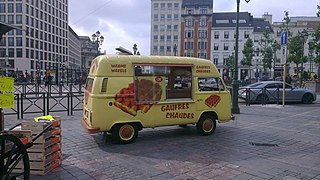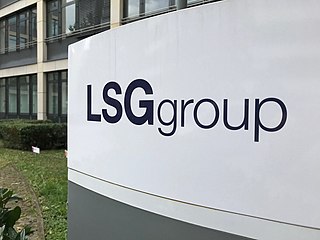
KLM Royal Dutch Airlines, legally Koninklijke Luchtvaart Maatschappij N.V., is the flag carrier of the Netherlands. KLM is headquartered in Amstelveen, with its hub at nearby Amsterdam Airport Schiphol. It is a subsidiary of the Air France–KLM group and a member of the SkyTeam airline alliance. Founded in 1919, KLM is the oldest operating airline in the world, and has 35,488 employees with a fleet of 110 as of 2021. KLM operates scheduled passenger and cargo services to 145 destinations.

A restaurant is a business that prepares and serves food and drinks to customers. Meals are generally served and eaten on the premises, but many restaurants also offer take-out and food delivery services. Restaurants vary greatly in appearance and offerings, including a wide variety of cuisines and service models ranging from inexpensive fast-food restaurants and cafeterias to mid-priced family restaurants, to high-priced luxury establishments.

Cathay Pacific Airways Limited (CPA), more widely known as Cathay Pacific, is the largest carrier of Hong Kong with its head office and main hub located at Hong Kong International Airport. The airline's operations and its subsidiaries have scheduled passenger and cargo services to over 190 destinations and more than 60 countries worldwide including codeshares and joint ventures. Cathay Pacific operates a fleet consisting of Airbus A321neo, Airbus A330, Airbus A350, and Boeing 777 aircraft. Cathay Cargo operates two models of the Boeing 747. Defunct wholly-owned subsidiary airline Cathay Dragon, which ceased operations in 2020, operated to 44 destinations in the Asia-Pacific region from its Hong Kong base. In 2010, Cathay Pacific and Cathay Cargo, together with Cathay Dragon, transported nearly 27 million passengers and over 1.8 million tons of cargo and mail.

Recipe Unlimited Corporation is a Canadian company that operates several restaurant chains such as Swiss Chalet, Harvey's and The Keg, and food distribution for large operations.

A food truck is a large motorized vehicle or trailer equipped to store, transport, cook, prepare, serve, and/or sell food.

Business class is a travel class available on many commercial airlines and rail lines, known by brand names which vary, by airline or rail company. In the airline industry, it was originally intended as an intermediate level of service between economy class and first class, but many airlines now offer business class as the highest level of service, having eliminated first class seating. Business class is distinguished from other travel classes by the quality of seating, food, drinks, ground service and other amenities. In commercial aviation, full business class is usually denoted 'J' or 'C' with schedule flexibility, but can be many other letters depending on circumstances.

An airline meal, airline food, or in-flight meal is a meal served to passengers on board a commercial airliner. These meals are prepared by specialist airline catering services and are normally served to passengers using an airline service trolley.

Finger foods are small, individual portions of food that are eaten out of hand. They are often served at social events. The ideal finger food usually does not create any mess, but this criterion is often overlooked in order to include foods like tacos. One origin for finger foods is the French canapé.

Mobile catering is the business of selling prepared food from some sort of vehicle. It is a feature of urban culture in many countries. Mobile catering can be performed using food trucks, trailers, carts and food stands with many types of foods that can be prepared. Mobile catering is also used to provide food to people during times of emergency.

Ground support equipment (GSE) is the support equipment found at an airport, usually on the apron, the servicing area by the terminal. This equipment is used to service the aircraft between flights. As the name suggests, ground support equipment is there to support the operations of aircraft whilst on the ground. The role of this equipment generally involves ground power operations, aircraft mobility, and cargo/passenger loading operations.
The Emirates Group is a state-owned Dubai-based international aviation holding company headquartered in Garhoud, Dubai, United Arab Emirates, near Dubai International Airport. The Emirates Group comprises dnata, an aviation services company providing ground handling services at 126 airports, and Emirates Airline, the largest airline in the Middle East. Emirates Airlines flies to over 150 destinations across 6 continents, operating a fleet of over 250 wide-bodied aircraft. The airline has 170 aircraft on order worth US$58 billion. The Emirates Group has a turnover of approximately US$28.3 billion and employs over 105,000 employees across all its business units and associated firms, making it one of the biggest employers in the Middle East. The company is wholly owned by the Government of Dubai directly under the Investment Corporation of Dubai and as part of Dubai Inc.
Dubai National Air Travel Agency is an Emirati airport services provider which provides aircraft ground handling, cargo, travel, and flight catering services across five continents.
Airline reservation systems (ARS) are systems that allow an airline to sell their inventory (seats). It contains information on schedules and fares and contains a database of reservations and of tickets issued. ARSs are part of passenger service systems (PSS), which are applications supporting the direct contact with the passenger.

Royal Brunei Catering is a company whose main business is in the catering and restaurant business. It was a wholly owned subsidiary of Royal Brunei Airlines.

Emirates Flight Catering (EKFC) is an in-flight catering service based in Dubai, United Arab Emirates, which provides catering and support services for Emirates Airline and all other airlines based at Dubai International Airport. It is a subsidiary of The Emirates Group.
Gategroup is a Swiss company providing services to the travel industry, including catering, onboard retail, food service provisioning, and food logistics. It serves as the parent company for four core brands, and is a supplier to many major airlines. Its head office is in Glattbrugg, Switzerland, near Zurich Airport.
ZeroCater is a food service company headquartered in San Francisco, California, specializing in providing companies with catered meals from local restaurants, caterers, and food trucks. The company expanded its offerings in 2017 to include a fully customizable solution for office snacking called ZeroCater Snacks and Kitchens and, in 2018, to deliver alcohol with Zerocater Pours. The company launched Enterprise Catering for companies with 500 or more employees in 2019. Zerocater currently feeds thousands of employees of companies including Slack, PagerDuty, Chan Zuckerberg Initiative, Salesforce, JUUL, Datadog, and Cisco Meraki. As of November 2017, ZeroCater operates in the San Francisco Bay Area, New York City, Los Angeles, Austin, Washington, D.C., and Chicago.
Phila Hach — pronounced "File-ah Hah" was an American chef, restaurant owner, innkeeper, and caterer who authored 17 cookbooks, including recipe collections for the 1982 World's Fair, Opryland USA and Cracker Barrel restaurants. She has been called the "grand dame of southern cooking" and counted as good friends Duncan Hines and Julia Child. Hach catered functions for the United Nations, U.S. mayors and governors, military personnel and celebrities, and was one of the pastry chefs at the wedding of Princess Diana.

On February 3, 1975, 197 people fell ill aboard a Japan Air Lines Boeing 747 en route from Anchorage, Alaska, to Copenhagen, Denmark, after consuming an in-flight meal contaminated with Staphylococci. One hundred and forty-four people needed hospitalization, making it the largest food poisoning incident aboard a commercial airliner.

LSG Group, registered as LSG Lufthansa Service Holding AG, is an aviation services company that manages multiple brands, including LSG Sky Chefs and Retail inMotion. The company's world headquarters is located in Neu-Isenburg, near Frankfurt, Germany. Its North American headquarters is located in Irving, Texas, United States. In February 2018, LSG Sky Chefs co-founded the Airline Catering Association, which is based in Brussels, Belgium.















